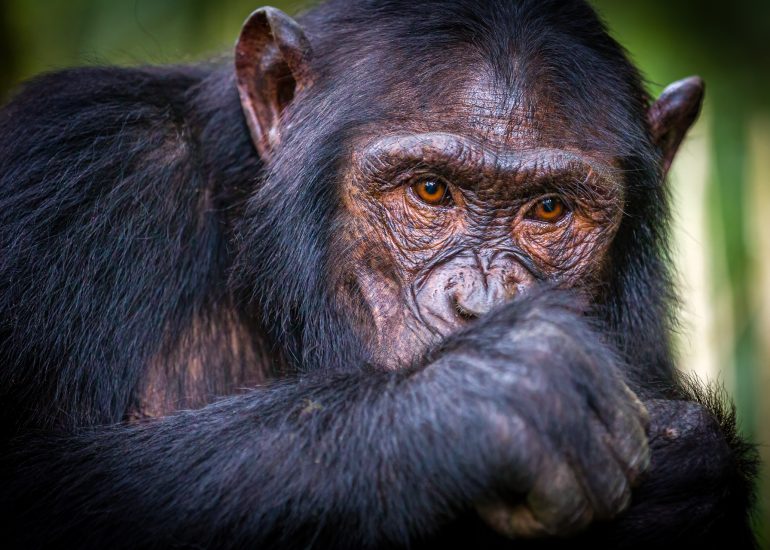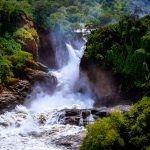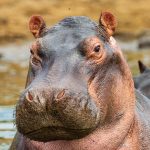Uganda
Journal
The Pearl Of Africa
Part 4
Day 8
Murchison to Kibale
In the morning after the breakfast we start from Murchison Fall National Park, and travel south towards the town of Masindi. The road gradually starts to climb as we approach the escarpment, with stunning views of the Rift Valley spreading out before us. We pass through numerous small towns and villages, with locals going about their daily lives. The road wind its way up the steep escarpment, with sharp drops on one side and towering cliffs on the other.The journey continues through a sea of different shades of green as we drive through the wide tea fields. It has something incredibly calming.
The streets here are relatively empty. Every now and then we see a Boda Boda or even another car. Even today, our journey is relatively long and we do not expect to arrive at our next destination until late afternoon.
However, long car trips also make you hungry in Uganda and at some point Innocent comes up with the idea that we absolutely have to try the traditional street food from Uganda. So in the next city we make a stop and let us explain at a stand how to make Chapati and Rolex.
Chiapati & Rolex
Chapati and Roles are two popular street foods in Uganda.Chapati is a type of unleavened flatbread made from wheat flour, water, and salt. It is rolled out into thin circles, then cooked on a hot griddle until lightly browned. Chapatis are typically eaten as a snack or with a main meal and are often served with stew, beans, or vegetables. Rolex, on the other hand, is even more popular as a street food and consists of a rolled chapati filled with a mixture of scrambled eggs, onions, tomatoes, and sometimes vegetables or meat. The name „Rolex“ is a play on the words „rolled“ and „eggs“ and is a popular quick breakfast option in Uganda.
Both chapati and rolex are widely available from street vendors and small food stalls across Uganda, and they are both affordable and delicious. They have become a part of Ugandan food culture, and many people enjoy them as a quick and satisfying snack or meal on-the-go. We take our Chapati on-the-go and continue to the top of the escarpment, and then finally enter the lush and fertile region of Kibale. The scenery changes dramatically, with rolling hills covered in green vegetation and small farms dotting the landscape. As we near Kibale, we see the forest reserve looming in the distance, with its dense canopy of trees and unique wildlife.
Baboons
Before we enter the road to our next accommodation we meet a group of baboons with a lot of baby baboons amongst them. They are partially sitting beside or even in the middle of the road. They observe us curiously and probably they are speculating on food. However the rule is clear – we are not going to feed wild animals no matter what. We take our time and observe them playing and caring each other.
Turaco Tree Tops Lodge
Finally we arrive at our today’s destination. The Turaco Tree Tops Lodge
The Turaco Tree Tops Lodge is an eco-lodge that offers guests an opportunity to stay in the treetops of a beautiful forest, surrounded by wildlife and nature. The lodge is located near Kibale Forest, which is known for its population of chimpanzees and other primates, making it an ideal location for those interested in visiting our closest relatives in the animal kingdom. The lodge features several spacious and comfortable houses, each with its own balcony and stunning views of the surrounding forest. The rooms are designed to blend seamlessly with the natural environment, and offer guests a peaceful and relaxing retreat.
The Turaco Tree Tops Lodge offers a variety of activities for guests, including guided walks through the forest, chimpanzee tracking, and bird watching. The lodge also has a restaurant that serves a range of local and international cuisine, as well as a bar and lounge area where guests can relax and unwind after a day of exploring the forest.
Kibale Forest
Kibale Forest National Park is a verdant tropical rainforest located in western Uganda, covering an area of about 800 square kilometers. It is widely regarded as the primate capital of the world, home to an incredible 13 different species of primates, including chimpanzees, baboons, colobus monkeys, and more. The forest is a protected area, and as a visitor to Kibale Forest National Park one can participate in a range of activities to experience the incredible diversity of primate species that call this forest home. One of the most popular activities is chimpanzee tracking, which involves hiking through the forest with a guide to locate and observe these intelligent and fascinating creatures in their natural habitat.
In addition to chimpanzee tracking, visitors can also go on guided nature walks, bird watching tours, and explore the forest on their own. Kibale Forest is home to over 300 bird species, as well as a variety of other wildlife such as elephants, leopards, and duikers. The forest is an important conservation area, as many of the primate species found here are endangered or vulnerable. Kibale Forest is managed by the Uganda Wildlife Authority, and efforts are made to protect and preserve the forest and its inhabitants for future generations.After the long drive we are pretty tired and with the sound of the jungle surrounding us we have a last drink at the bar before we walk back to our little hut to spend the night – tomorrow is Chimpanzee Tracking!
Day 9
Chimpanzee Tracking
Although the mountain gorillas usually steal the spotlight during a visit to Uganda, chimpanzee tracking is also pretty cool and the experience shouldn’t be underestimated.
It is an early humid morning in Kibale National Park while going for chimpanzee tracking can be quite an atmospheric experience. The air is thick with moisture, and the forest is shrouded in mist, creating an otherworldly ambiance. As we make your way to the park headquarters, the sun has yet to rise, and the sky is still a bit dark, with just a hint of light on the horizon. The air is cool, but you can feel the humidity on your skin, making you feel slightly sticky.
Once we arrive at the park headquarters, we are greeted by the sounds of birds chirping and the chatter of other visitors getting ready for their own chimpanzee tracking experience. The park rangers provide us a briefing about the chimpanzees and the rules for observing them, and finally we are then divided into small groups and assigned a guide and a team of trackers. As we begin our trek into the forest, the air becomes even more humid, and the thick vegetation begins to close in around us. The forest is alive with the sounds of birds, insects, and monkeys calling to one another.
The mist still hangs low in the trees, giving the forest an eerie, almost mystical quality. The ground beneath our feet is damp and soft, with the occasional muddy patch that requires careful navigation. We get closer to the chimpanzees, and the atmosphere becomes even more charged, with the anticipation of seeing these amazing animals in their natural habitat. The guides lead us deeper into the forest, and we can hear the chimpanzees calling to one another in the distance. This is the jungle. The we get to commando: „come on, fast, pay attention where you set you foot but come fast“ and we are running, running through the jungle.
Enjoy the entire show.
Finally, we see the first chimpanzees, and the experience of seeing them up close and personal is both exhilarating and humbling. As we watch them interact with one another, you can’t help but feel a sense of awe at the incredible diversity of life that surrounds us. One could feel also a little nervous about being so close to them. Very close.
Even closer than we thought at the beginning. Suddenly a full-grown chimpanzee stands right next to me. The ranger shouts: „don’t run away“ and I’m so fascinated and just say, „who wants to run away from here, that’s why I’m here“? I stand still very calmly and watch my „relatives“. But he doesn’t find me so interesting and soon goes in the direction of an overturned tree to settle on it. Since the rest of the group has probably just hunted and caught a smaller monkey, it is „rained“ fur remains and chunks of meat from the tree peaks. My new friend grabs the food and is visibly happy that he didn’t have much work with it. As we make our way back to the park headquarters, I feel a sense of accomplishment and a deep happiness. This has been an amazing and fascinating experience.
About Chimpanzees
- Chimpanzees are one of the closest living relatives to humans, sharing 98% of our DNA.
- They are found in 21 African countries, from west to east, and live in a variety of habitats, from rainforests to savannas.
- Chimpanzees are highly social animals, living in communities of up to 150 individuals, with a dominant male as the leader of the group.
- They use a variety of tools, such as sticks, rocks, and leaves, to help them gather food and water.
- Chimpanzees have a complex communication system, using a combination of vocalizations, gestures, and facial expressions to convey messages to one another.
- They are omnivores, meaning they eat both plant and animal matter, and have been known to hunt small mammals such as monkeys and duikers.
- Chimpanzees have been observed exhibiting behaviors that were once thought to be unique to humans, such as empathy, altruism, and the ability to plan for the future.
- Unfortunately, chimpanzees are listed as an endangered species, with populations declining due to habitat loss, hunting, and disease.
Back in our accommodation and we are still fascinated and enthusiastic about what we have just experienced in the Kibale Forest in the morning. We relax a little on the terrace and drink a beer. The morning was incredible. However, we don’t have much time to rest. Innocent already has a plan for the afternoon. A visit to the Bigodi Wetland Sanctuary is on the agenda.
Bigodi Wetland Sanctuary
Bigodi Wetland Sanctuary is a protected area located close to Kibale Forest, near the town of Fort Portal. It is an ecotourism site managed by the local community and serves as an important habitat for a diverse range of wildlife species, including primates, birds, and butterflies. Walking through the sanctuary, visitors can observe several primate species, including the red colobus monkey, black-and-white colobus monkey, L’Hoest’s monkey, and grey-cheeked mangabey. There are also several bird species that can be spotted, such as the great blue turaco, African pied wagtail, and weaver birds.
One of the main attractions of the sanctuary is the opportunity to see several species of wetland birds, including the shoebill stork, which is an endangered bird that is endemic to Africa. Visitors can also see a wide variety of butterflies and other insects in the sanctuary.
In addition to the wildlife, visitors can learn about the local community’s efforts to conserve the wetland ecosystem and promote sustainable tourism. The sanctuary offers guided walks through the wetland, led by knowledgeable local guides who can share information about the ecology and cultural significance of the area.
We begin our walk through the Bigody Wetland Sanctuary together with Robert. Robert is our guide and what I can say is that Robert is an amazing bird spotter. He has eagle eyes.
Before long, we hear the unmistakable sound of baboons in the distance and as we approach, we see a group of them gathered in a clearing, grooming each other and chattering noisily. Continuing on our walk, we keep our eyes peeled for the red colobus monkeys that are known to live in the sanctuary. It’s not long before we spot a small group of them in the trees, their russet-colored fur contrasting beautifully with the lush greenery around them. They’re incredibly agile, leaping from branch to branch with ease.
Great Blue Turaco
As we make our way further into the sanctuary, we hear the distinctive call of the great blue turaco. It’s a haunting sound, and we’re thrilled when we catch sight of one perched high up in a tree. Its vibrant blue feathers are stunning, and we watch in awe as it spreads its wings and takes flight.
The Great Blue Turaco (Corythaeola cristata) is a bird species native to sub-Saharan Africa. It is known for its striking blue and green plumage, with a distinctive crest on its head. Great Blue Turacos are generally found in forested areas and woodlands, where they feed on fruit, leaves, and flowers. They are social birds, often seen in small groups or pairs, and are known for their loud and distinctive calls. These birds can grow up to 70 cm (27 inches) in length, with a wingspan of up to 90 cm (35 inches). They are also known for their unique flight style, which involves a series of slow flaps followed by a glide.
Great Blue Turacos are monogamous and mate for life. They build their nests in trees, using sticks and twigs, and lay 1-2 eggs at a time. Both parents take turns incubating the eggs and caring for the chicks. The Great Blue Turaco is considered a species of least concern by the International Union for Conservation of Nature (IUCN), although its population is thought to be declining due to habitat loss and hunting.
Doing some business
After a while we meet, somewhere in the middle of the forrest, two very young „business men“ selling self made merchandise. The two little guy are tough negotiators and finally we close a deal. We buy a hand crafted Turaco and a Chimpanzee leaving our money with the two „business owners“.
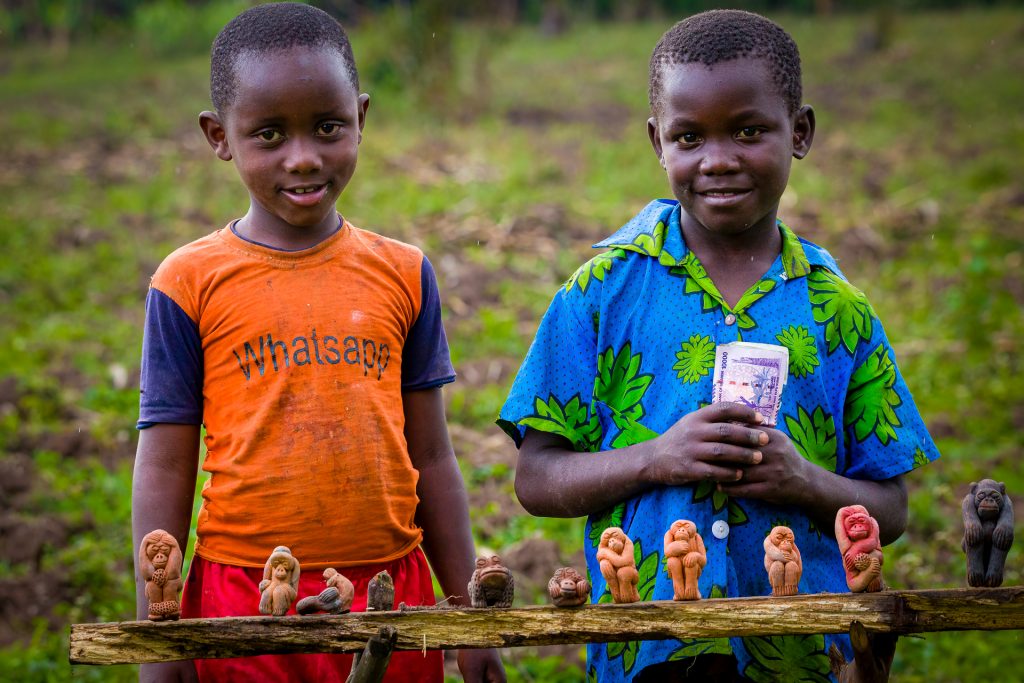
Finally, as we’re nearing the end of our walk, we hear the unmistakable call of a woodland kingfisher. We can spot him from a distance and unfortunately we are too far away from him to take a picture. Probably later I thought and we are going to meet this colorful bird again.
After this beautiful experience we drive back to the Turaco Tree Top lodge and we process the fantastic impressions of this unique day. Together with Robert we have a beer at the bar talking still about the amazing wildlife we have seen today.
Day 10
Sempaya Hot Springs Semuliki National Park
After breakfast we say good bye and from Kibale Forest we drive back towards the town of Fort Portal, which is about 26 kilometers away. From Fort Portal, we turn onto the Bundibugyo road and drive for about 40 kilometers to the entrance of Semuliki National Park. The road is a bit rough in some places, but it is still passable with a 4×4 vehicle. Along the way we cross several small rivers and streams, which can be quite picturesque.
Approaching Semuliki National Park, we notice a change in the scenery. The forest becomes denser, and the landscape becomes more hilly. The park is known for its hot springs and meanwhile we have an idea why Innocent stopped at local market to buy potatoes. Assumingely we are going to cook them in the hot springs which are located in a section of the park called Sempaya Hot Springs, which has two main hot springs, known as the male and female springs. The male spring is called Bintente, and it is a boiling geyser that spouts water up to 2 meters high. The female spring, on the other hand, is called Nyasimbi, and it is a large pool of bubbling water with temperatures that can reach up to 103 degrees Celsius.
Beside the Sempaya Hot Springs there are many little pools with more ambient water. They are believed to have healing powers, and many locals come to bathe in the warm waters for various ailments. Visitors to the park can also enjoy the therapeutic benefits of the hot springs by taking a dip in the natural pools. The water is rich in minerals, including sulfur, magnesium, and potassium, which are known to have many health benefits.
Apart from the therapeutic benefits, the two hot springs are also a unique natural wonder to witness. The steam rising from the springs creates an ethereal atmosphere, and the surrounding forest and hills provide a beautiful backdrop. Visitors can also learn about the cultural and historical significance of the hot springs from the knowledgeable park guides. It’s worth noting that the hot springs are located within the park, and visitors are required to pay an entry fee to access them.
Visitors to Semuliki National Park are required to be accompanied by a park ranger or guide when visiting the hot springs. These guides are knowledgeable about the park and can provide valuable information about the hot springs and the surrounding ecosystem. They also ensure that visitors stay safe while enjoying the natural wonder of the hot springs.
So, while the temperature of the hot springs in Semuliki National Park is too high for humans to take a bath, visitors can still enjoy the therapeutic benefits of the natural pools and soak in the warm water surrounded by the beauty of the park.
While the water in the hot springs of Semuliki National Park is not recommended for cooking due to safety and environmental concerns, it is possible that park rangers or guides may use the hot water for cooking potatoes or other food items in certain situations.
However, it’s important to note that cooking food in the hot springs is not a common practice and is not recommended for visitors to the park. The park authorities may have specific guidelines or regulations for park rangers or guides on how to use the hot springs for cooking, and it’s important to follow these guidelines to ensure the safety of both humans and the environment.
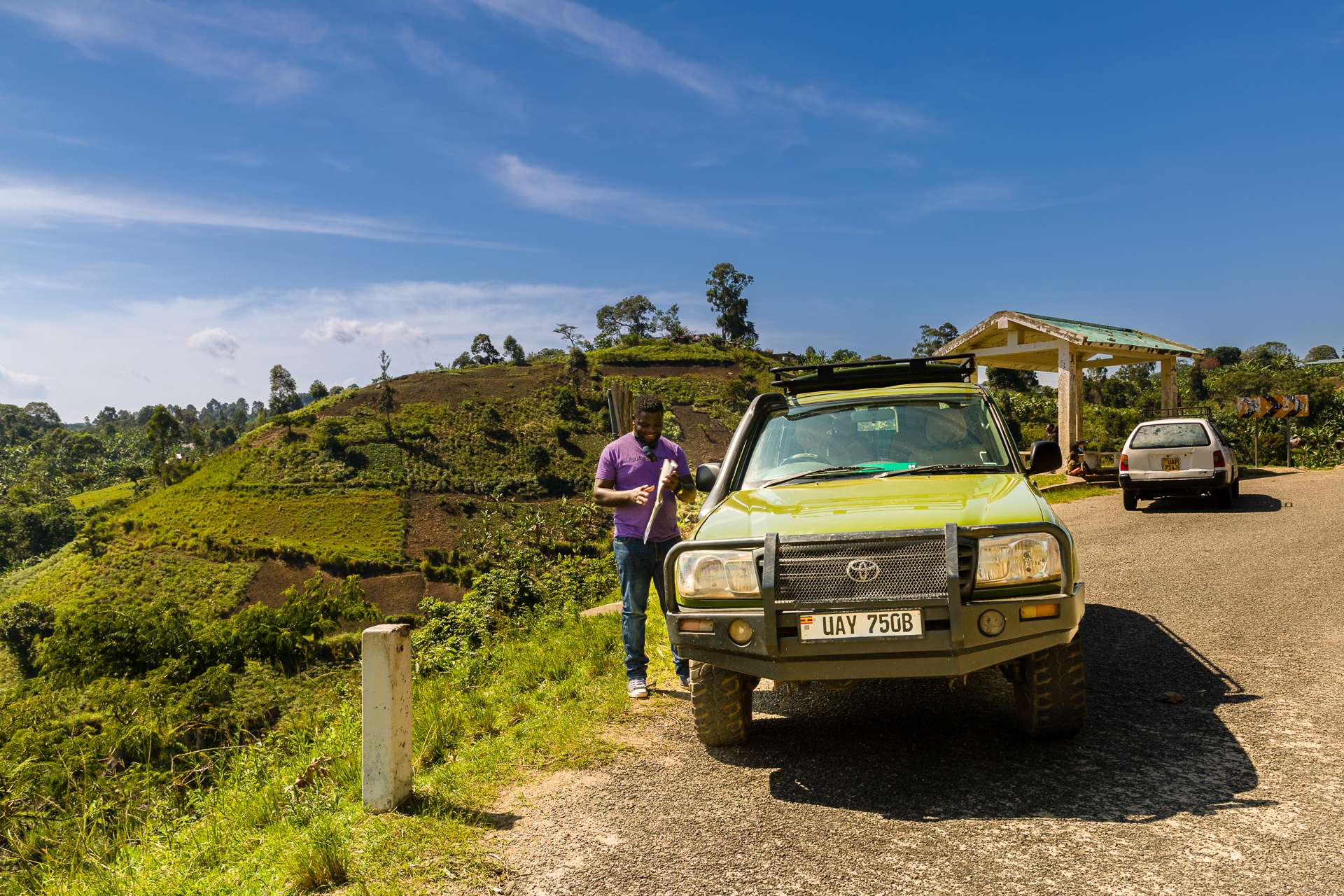
Innocent planning the route
The drive from Semuliki National Park to the Mountains of the Moon Hotel in Fort Portal takes about 2-3 hours, depending on the route taken. The road is generally in good condition, but some parts may be bumpy or unpaved, so it’s advisable to use a sturdy vehicle.
The route from Semuliki to Fort Portal is quite scenic, passing through lush green countryside, small towns, and villages. Along the way, visitors may catch glimpses of traditional homesteads, farms, and local markets.
Mountains of the Moon Hotel is a beautiful and luxurious hotel located in the heart of Fort Portal, a town nestled in the foothills of the Rwenzori Mountains. The hotel offers stunning views of the surrounding mountains and is a perfect base for exploring the nearby national parks, including Kibale Forest, Queen Elizabeth, and Semuliki National Park.
The hotel boasts of spacious and elegantly decorated rooms, each featuring a private balcony or terrace with panoramic views of the mountains or the lush gardens. The hotel also has a range of amenities, including a swimming pool, fitness center, spa, and restaurant serving delicious local and international cuisine.
The hotel’s location and amenities make it a popular choice for visitors to the area, whether for business or leisure. The staff are friendly and professional, and the hotel offers a relaxing and tranquil atmosphere, making it an ideal place to unwind after a day of exploring the beautiful surroundings.
Tomorrow we proceed our journey from here to the Queen Elizabeth National Park – crossing the Equator for the first time in a car.
Portfolio
Uganda
"Africa has her mysteries, and even a wise man cannot understand them. But a wise man respects them" — Miriam Makeba
Birds Uganda
“Some birds are not meant to be caged, that's all. Their feathers are too bright, their songs too sweet and wild. So you let them go, or when you open the cage to feed them they somehow fly out past you. And the part of you that knows it was wrong to imprison them in the first place rejoices, but still, the place where you live is that much more drab and empty for their departure.” ― Stephen King, Rita Hayworth and Shawshank Redemption
Wildlife Uganda
“The more you learn about the dignity of the gorilla, the more you want to avoid people.” - Diane Fossey



